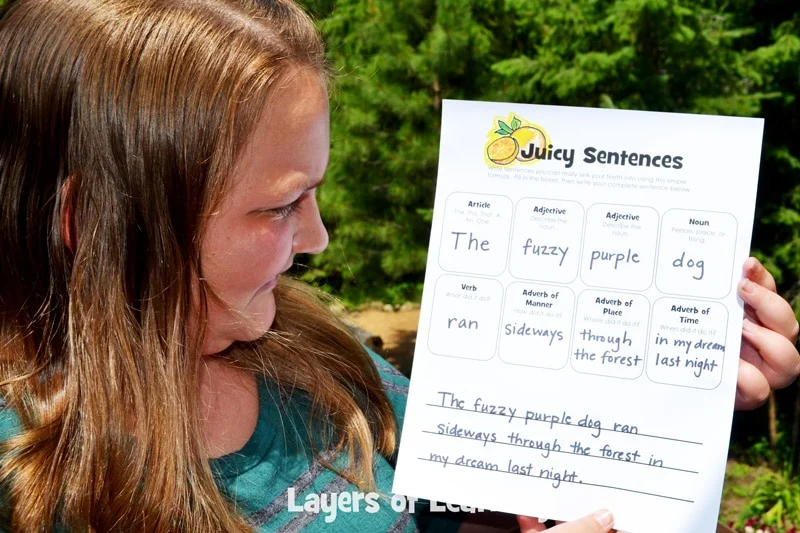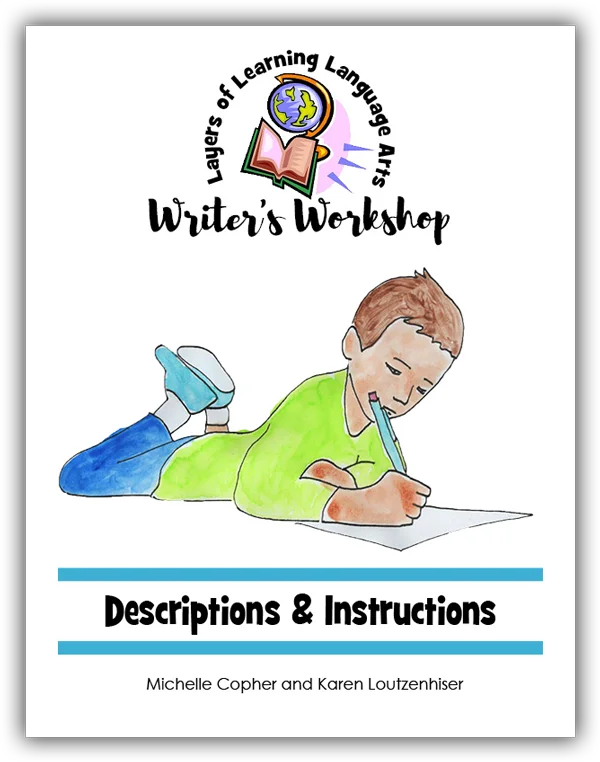Writer’s Workshop is a writing program for your whole family, from emergent writers right up to Mom and Dad. This is a sample exercise about descriptive writing and adding details. Try it with your kids.
This Writer’s Workshop exercise is from Writer’s Workshop Descriptions and Instructions. In Descriptions and Instructions, you’ll learn how to use vivid language and precise word choice. You’ll play with words, learn literary devices, and create varied and interesting descriptions and precise instructions. You’ll begin to think of writing as an art form and yourself as an artist who crafts the words. Your whole family will work together and help each other become stronger writers. Join us for a family-style writing program in Writer’s Workshop.
Descriptive writing doesn’t always come naturally, but it’s a skill you can learn, step by step. Adding details to writing is a simple step that can drastically improve the quality of the writing.
The dog sat.
I wore a hat.
The cat was soft.
Yawn. Boring, same old sentences. Boring, same old stories.
Instead, write sentences you can really sink your teeth into – juicy sentences.
Step 1 Mini-Lesson
Start each Writer’s Workshop lesson off with a 5-10 minute mini-lesson with all of your kids. The sidebars of each Writer’s Workshop unit are lined with mini-lesson ideas to help your kids learn grammar, punctuation rules, and writing skills. For this lesson, you could discuss this quote by Mark Twain that applies to descriptive writing:
Mark Twain said, “The difference between the right word and the almost right word is the difference between lightning and the lightning bug.” What do you think he meant?
Step 2 Exercise: Juicy Sentences
Spend most of your Writer’s Workshop time on the exercise, which should last as long or as short as you need it to each day.
Writing with description is an important and practiced skill, not one that naturally comes with time. You’ll need the “Juicy Sentences” printable for this exercise.
First, write “The” in the article box, “dog” in the noun box, and “ran” in the verb box.
Now, close your eyes and picture the dog exactly, then describe what is in your mind. It might be a large, honey-colored dog with a blue collar running through the park near our house. Or it could be a tiny white toy poodle with a pink and black collar with a little bell on it running through a shopping mall. See how the same sentence can yield two very different pictures? As writers, it is our job to paint a picture for our readers.
Next, fill in the other boxes on the printable. Here’s an example of a completed exercise.

To conclude, explain that not every sentence needs to follow this precise format to be juicy. When you think of juicy sentences, think about adding details in a variety of orders and ways. Practice writing some juicy sentences and add them to the Journal section of your Writer’s Notebook.
Step 3: Writing Project
Most exercises stay in the Writer’s Notebook to be used as a reference, for inspiration, or to be tossed at a later date. About once a month, one piece of writing should be taken clear through the writing process. This piece becomes your writing project for the unit.
As you are working on the writing project for Descriptions and Instructions, you might pull out the Juicy Sentences exercise and see if you can make some of the sentences in your project ones that you can really sink your teeth into using this pattern.
You can learn details about the writing process and how to mentor writers in the Writer’s Workshop Guidebook.
Step 4: Evaluating Writing
Every piece of writing that makes it to publication needs to be shared before an audience and then evaluated. The audience should cheer for the writer and ask curious and positive questions about the writing when appropriate. Evaluations should be designed to help the writer grow, not just to create a grade. Every Writer’s Workshop unit comes with specific helps for the writing mentor, including a rubric that is specific to the genre being taught. General writing evaluation criteria and strategies are taught to the parent or mentor in the Writer’s Workshop Guidebook.
What You’ll Find in Every Writer’s Workshop Unit
Printables
You’ll find printables in every Writer’s Workshop unit. They are tools for helping kids learn the writing process, skills, and ways to write in specific genres. They make lessons in a family-school setting a little more manageable for parents too.
Idea Banks
In each unit, kids will be doing a variety of writing exercises as well as one project. They will learn to take their project through the writing process, incorporating what they’ve learned during the exercises in the unit. Each unit has a big idea bank for kids to choose from so they can find something meaningful to write about in each genre.
Rubrics
Every unit also includes a rubric to help parents or mentors know how to give feedback that will help writers grow. Rubrics are tools writers can use to self-check, and mentors can use to know what to look for in each writing genre. We never just slap a grade on writing. Every bit of feedback is a tool to improve and grow.
More Writer’s Workshop

Learn more about Writer’s Workshop and how it can help you create writers (not just grammar workbook filler-outers!). We invite you to check out the Writer’s Workshop Curriculum Guide. Then see how Layers of Learning can change your whole homeschool into a happy, hands-on family school with the Writer’s Workshop Guidebook. We believe learning is about exploring! If you like exploring, you’ll love the rest of the Layers of Learning program too – history, geography, science, and art, all taught with your whole family exploring together.
Get a Free Unit
Choose between the first unit in each Layers of Learning subject to try for free when you sign up for the newsletter.
We never spam and you can cancel your subscription at any time.





I copied and printed smaller version to put in their ELA notebooks! Superb activity to start narratives! Thank you.
Glad it worked well for you Jill! Have a fantastic day. (:
Could you kindly send me the graphic organizer for the juicy words? I love it!
Sev, The post has been updated and the link to the “Juicy Sentences” printable restored. Thanks for drawing our attention to this.